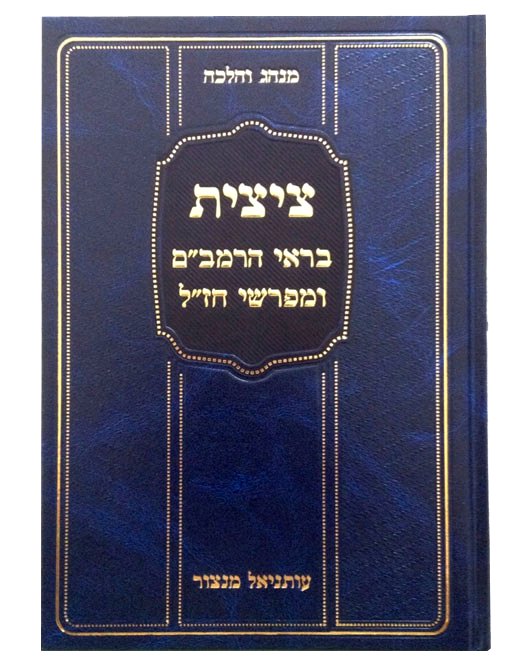
בספר זה מבקש המחבר הרב עתניאל מנצור יצ"ו, להתחקות אחר מנהגי יהודי תימן עתיקי היומין הנוגעים למצוות הציצית. להליכות יהודי תימן נודעת חשיבות היסטורית ודתית עצומה הואיל והם ייחודיים בנאמנותם לפסיקה התלמודית כפי שבאה לידי ביטוי במשנה תורה, לידיעה דתית-השקפתית כפי שבאה לידי ביטוי במורה הנבוכים, ולביאורי המקרא ולדרך המחשבה שהנהיג רבנו סעדיה גאון. זאת ועוד, יסודות מורשת יהודי תימן הונחו עוד בימי בית המקדש הראשון, וראויה היא שייאמר עליה "מנהג אבותינו תורה הוא".
בספר זה המחבר מציג מסורות קדומות באופני ההתעטפות בציצית, בוחן את התאמתן לפסיקה התלמודית, ומשווה מה ביניהם לבין מנהגי העדות השונות הנהוגים כיום. "אמרו עליו על רב תלמיד רבנו הקדוש, שכל ימיו לא ראוהו שהלך ארבע אמות בלא תורה, או בלא ציצית, או בלא תפילין". יהודי תימן לדורותיהם קיימו וקיבלו עליהם את מנהגו של רב, ורבים רבים מהם הלכו במשך כל היום וטליתותיהם עימהם, מוכנים ומזומנים לקיים כל מצווה שתבוא לידיהם בהידור בעטיפת טלית.
אחת ממסקנות הספר היא שהטלית והשימוש התדיר בה, היווה למעשה אמצעי חשוב בידי יהודי תימן לזכירת מצוות ה' ולזכירת דרך החיים התלמודית המקורית אשר יונקת ומחוברת לדת משה, ההלכתית והמחשבתית, ואשר שואבת את יפעתה ממשה רבנו שקיבל תורה בסיני. מטרת המחבר בספר זה, לבאר ולשמר את הליכותיהם עתיקי היומין של יהודי תימן בכל הקשור למצוות ציצית. בשל קדמותם, מנהגי יהודי תימן בולטים בייחודם מכל שאר עדות ישראל, כגון באופן ההתעטפות בציצית, בזמני ההתעטפות בטלית ומשך ההתעטפות, ואם נתבונן נגלה, כי גם בצבע הטלית של יהודי תימן, שאינו דומה לצבעה בימינו, טמונים רעיון ומחשבה.
יהודי תימן קשרו קשר אמיץ עם רבנו הרמב"ם ודבקו בו לאהבה, וזאת בעיקר לאור אחדות הדעים שהיתה ביניהם בענייני השקפה, הלכה ומוסר.
מסיבה זו, העיון במצוות הציצית בספר זה נערך לאור פסיקת רבנו הרמב"ם שהיה ועודנו מנהיגה הרוחני של עדת יהודי תימן. לאור דברים אלה, שם הספר "הציצית בראי הרמב"ם ומפרשי חז"ל", מבטא את מטרת המחבר להנציח את מנהגי יהודי תימן ועדות נוספות, ולצד תיאור המנהגים, לבאר את ההלכה התלמודית כפי שהיא באה לידי ביטוי בפסיקת הנשר הגדול.
Tsitsith Through the Lens of the Rambam & Hazal
In this book the author, Rabbi Othniel Mansoor, seeks to investigate the ancient customs of Yemenite Jewry related to the commandment of tsitsith. The practices of Yemenite Jews are known to be of historical and religious significance since they are unique in their fealty to the rulings of the Talmud; from how Talmudic law came to be stated in the Mishneh Torah, to the religio-philosophical outlook as expressed in the Guide to the Perplexed, to the explanations of the Scripture and the exegetical mindset espoused by Rabbenu Saadiah Gaon. Moreover, the foundations of Yemenite Jewish heritage were laid during the time of King Solomon's Temple, and thus it is worthy of the phrase "minhag avotenu torah hu - the custom of our fathers is Torah."
In this book the author presents the ancient traditions regarding the method of wrapping oneself in tsitsith, examines their suitability in light of Talmudic rulings, and compares them against the practices of various communities today. "They said concerning Rav, the student of Rabbi Yehudah HaNasi, that all of his days they never saw him walk four cubits without speaking words of Torah, or without tsitsith, or without tefillin." Yemenite Jews throughout their generations upheld and accepted upon themselves the custom of Rav, and a great many of them walked throughout the day having with them a tallith, ready and prepared to beautify any commandment that came into their hand by being wrapped in tallith while performing it.
One of the conclusions of the book is that the tallith and its frequent use was in fact an important tool in the hands of Yemenite Jews for remembering the commandments of HaShem and for remembering the original Talmudic way of life that draws from and is connected to dath Mosheh, both halakhically and in its thought, and which derives its splendor from Mosheh Rabbenu who received the Torah at Sinai. The goal of the author in this book is to explain and preserve the ancient customs of Yemenite Jewry in connection to the commandment of tsitsith. Because of their antiquity, the customs of Yemenite Jewry stand out as unique among all the other communities of Israel, such as the method of wrapping themselves in tsitsith, the times in which they wrap themselves in tsitsith, and the duration of their being wrapped in them. And if we look we find that even the colors used in a Yemenite tallith are unique and are not at all like the color of our times - times buried in idea and thought.
The Jews of Yemen developed a strong connection with Rambam our Teacher and lovingly clung to him primarily due to the unanimity that was between he and them in matters of philosophy, law, and ethics.
For this reason, the consideration of the commandment of tsitsith in this book is given is presented in light of the halakhic decisions of Rambam our Teacher, who was and continues to the be the spiritual leader of the Yemenite Jewish community. In light of this, the name of the book, "Tsitsith Through the Lens of the Rambam and the Commentaries of Hazal," expresses the goal of the author to immortalize the customs of Yemenite Jewry and other communities. And in addition to explaining such customs, the author also aims to explain the relevant Talmudic law as it has been expressed in the rulings of the "Great Eagle" (the Rambam).
Introduction by the Author, Rabbi Othniel Mansoor
Approbations by Great Rabbis of Our Time
Table of Contents and a Sample Chapter
Collection of Photos Depicting the Customs of Our Fathers Related to Tsitsith
